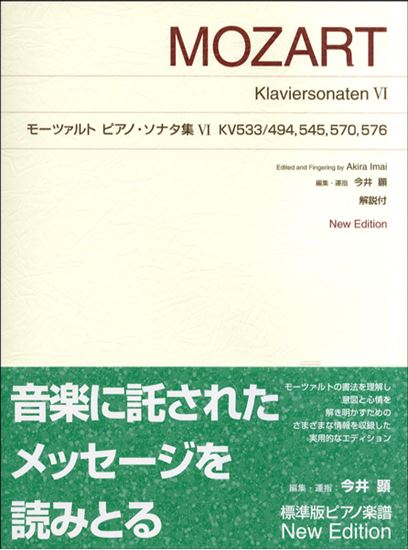Mozart, Wolfgang Amadeus : Sonate für Klavier Nr.16 B-Dur K.570
Work Overview
Publication Year:1796
First Publisher:Artaria
Instrumentation:Piano Solo
Genre:sonata
Total Playing Time:16 min 00 sec
Copyright:Public Domain
Additional Notes:新モーツァルト全集では、ソナタ番号が旧来の「16番」から「17番」へと変更された。
Commentary (1)
Author : Okada, Akihiro
Last Updated: December 1, 2009
[Open]
Author : Okada, Akihiro
Mozart's own 'Catalogue of Works' (Autograph Catalogue) bears the date February 1789 and the inscription 'Sonata for Clavier'. However, the first edition, published by Artaria in 1796 after the composer's death, is titled 'Sonata with Violin'. It is unclear whether this arrangement was made by Mozart himself, but the prevailing theory suggests it was done by someone else.
First Movement: B-flat Major, 3/4 time, Sonata Form
The main theme features an arpeggiated figure with a half-note + quarter-note rhythm, beginning in unison at the outset. This motive, which shows little developmental potential melodically or rhythmically, actually forms the core of the entire movement. Within a long transition section spanning 29 measures, a transitional theme in the subdominant key appears (from m. 23). The secondary theme in the dominant key is introduced by the opening idea of the main theme and consists of repeated notes and a stepwise descending figure (from m. 41). This theme also has a weak melodic character; the only cantabile idea in this movement is thus the transitional theme.
The latter half (from m. 80) begins with this transitional theme. It passes transiently through D-flat major, B-flat minor, F minor, and C minor, leading to G minor. After cadencing on the dominant chord, the secondary theme appears in G major. However, the tonic chord of G major is immediately reinterpreted as the dominant chord of C minor, and by inverting the upper and lower voices, it shifts to C minor, then F minor, and finally returns to the tonic key of B-flat major via B-flat minor.
After the recapitulation of the main theme (from m. 133) and the secondary theme in the tonic key (from m. 171), the movement concludes with a coda similar to that of the exposition (from m. 199).
Second Movement: E-flat Major, 4/4 time
An Adagio slow movement. The melodic line, depicting descending and ascending arpeggios, suggests an affinity with the main theme of the first movement. After an episode in C minor, the theme returns, and then an episode in A-flat major appears. While suggesting E-flat minor through the appearance of G-flat, the theme returns via the dominant chord. It should be noted that just before this second return of the theme, the Neue Mozart-Ausgabe suggests the insertion of an Eingang.
Third Movement: B-flat Major, 2/2 time
In contrast to the first movement, this movement begins with a theme characterized by a vibrant, upward-moving melodic line. Subsequently, a theme characterized by a syncopated rhythm appears (from m. 23). This theme is accompanied by a bass voice with repeated notes, and this motive will play a central role in the next section.
After a short two-measure bridge, a middle section characterized by repeated notes and chromatic descent begins (from m. 45). A passage of sixteenth notes with chromatic alterations connects seamlessly to the recapitulation of the opening theme (m. 63); after the recapitulation of the syncopated theme (from m. 71), the piece concludes with a short coda (from m. 85) where the repeated notes in the bass leave a lingering impression.
Movements (3)
PTNA & Partner Channel Videos(19items) View More
- favorite_border
- 0
Recording Location: 米国テキサス州フォートワース市 PepsiCo Recital Hall
- favorite_border
- 0
Recording Location: 米国テキサス州フォートワース市 PepsiCo Recital Hall
Sheet Music
Scores List (14)

(株)全音楽譜出版社

(株)全音楽譜出版社

(株)全音楽譜出版社

(株)全音楽譜出版社

(株)音楽之友社

(株)全音楽譜出版社

(株)ヤマハミュージックエンタテインメントホールディングス

(株)音楽之友社

(株)東音企画(バスティン)





















